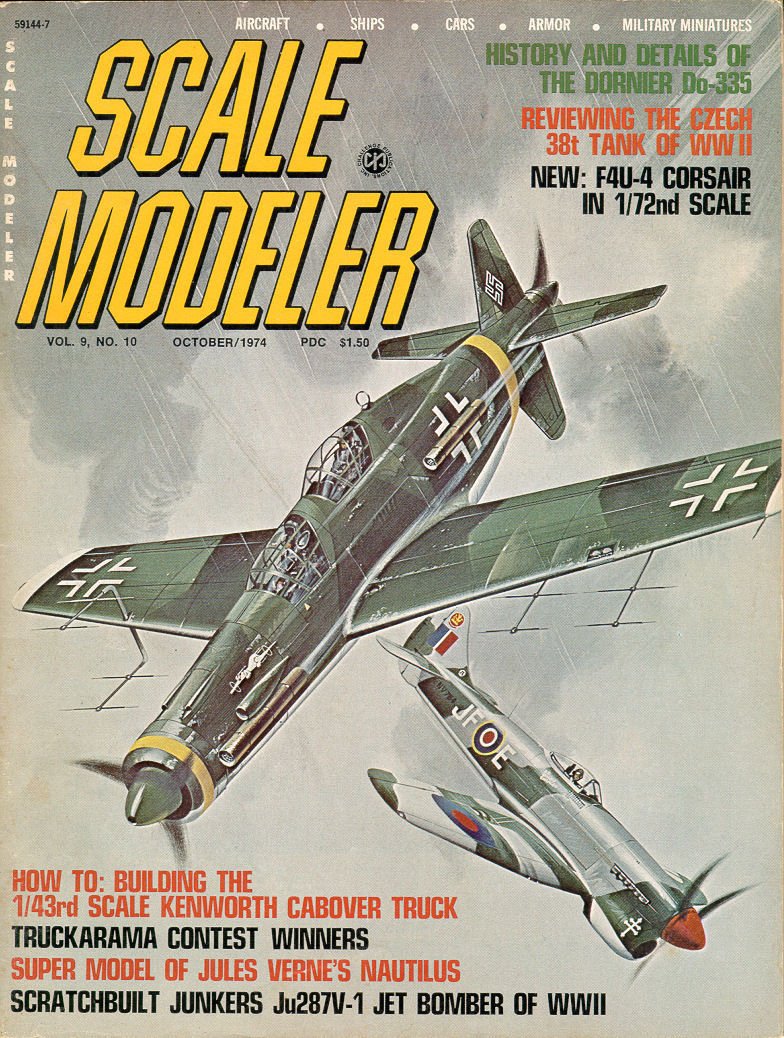

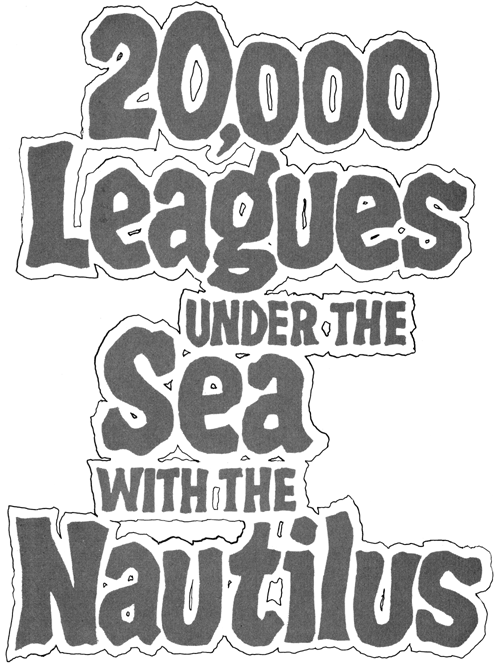 |
IN 1954, Disney Productions, headed by Walt Disney, was of course a going concern. It was during this year, how- ever, that Disney had decided to go really "big time" with his company. Three big irons were in the fire, so to speak. Two included the construction of Disneyland and the production of a new weekly television program. The third major undertaking centered around the model shown on these pages. Harper Goff and Walt Disney had come up with what they considered an excellent subject for an adventure movie. The production would be based on the Jules Verne novel 20,000 Leagues Under the Sea. Of significance was the fact that this would be Disney's first full length motion picture in the United States. No animation would be used. Understandably, the people at Disney Productions were hoping for a major success and thanks primarily to the brilliant production design by Harper Goff, the movie was indeed a triumph, one that went far beyond original hopes. While the production was still in the planning stages, one of the first items to be decided was the actual shape the famous submarine Nautilus would take. This ship was of course described loosely in the novel, but a definite design was obviously necessary for filming. Ray Disney, the brother of Walt and the man who apparently was supplying the capital for the movie, happened to be a cigar smoker. He preferred the type of cigar that came in the small aluminum cylinders. As he and Walt sat talking one day, it dawned on them that this might well be an excellent shape for the submarine. Such a craft would be modern even by today's standards, to say nothing of what would have been feasible in 1865. Upon learning of the Disney broth- ers' ideas concerning the ultra-sleek sub- marine concept, Harper Goff tried, ap- parently in vain, to convince those present at a board meeting (including the Disney brothers, of course) that in order for the movie to be as believable as possible, the submarine, as well as all additional equipment and paraphernalia, would have to be of a design and con- __________________________________ COLOR PHOTOS--Shown here are sev- eral views of Tom Scherman's NAUTILUS as well as a smaller replica of the brass version built after Harper Goff's first rough design. |
|
Although a prototype never truly existed, few ships are as well recognized throughout this country and the world as is the NAUTILUS, the famous submarine described by Jules Verne and so vividly brought to life by Walt Disney in the 1954 epic 20,000 LEAGUES UNDER THE SEA. ARTICLE BY FRANK JOHNSON MODEL BY TOM SCHERMAN |
|
 |
|
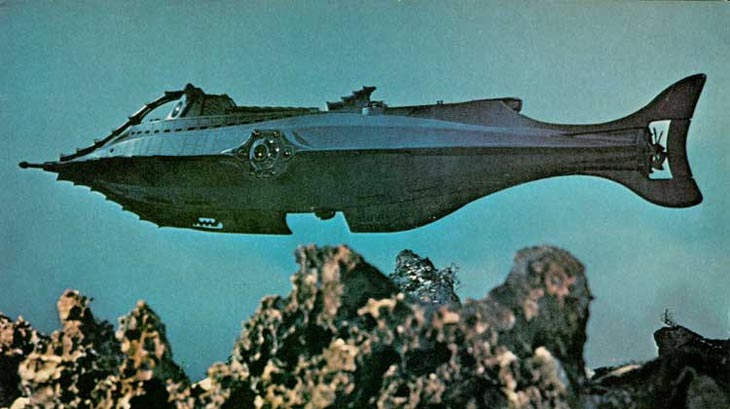 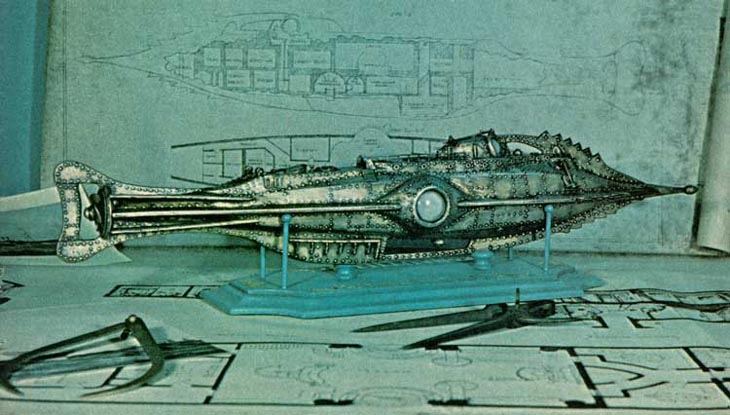  |
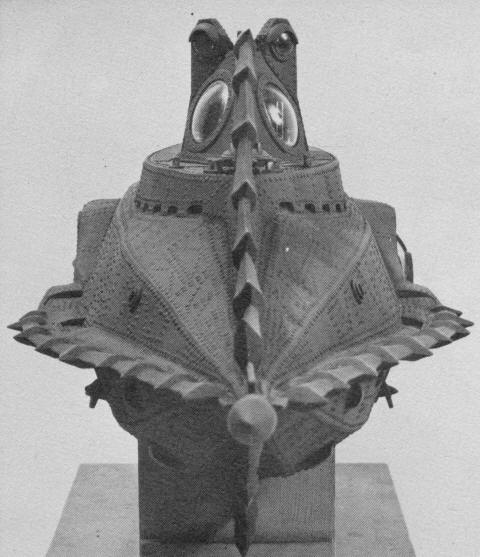 |
Imagine yourself as a seaman on a wooden sailing ship during the 1860s. Would a view of something like this slicing through the water strike fear in your heart? |
|
_________________________________________________________
struction that would have been possible _________________________________________________________ |
|
|
The scales on the NAUTILUS' spine are the only item made from wood. Thou- sands of rivet heads were applied to the hull. They are dots of 5-minute epoxy ap- plied with a toothpick. Needless to say, this was one of the more time consum- ing operations in the construction of the model. The original design for the sub called for an iron, all riveted hull. This was in keeping with construction methods of the 1860s. Welding, obviously, had not been invented yet. |
|
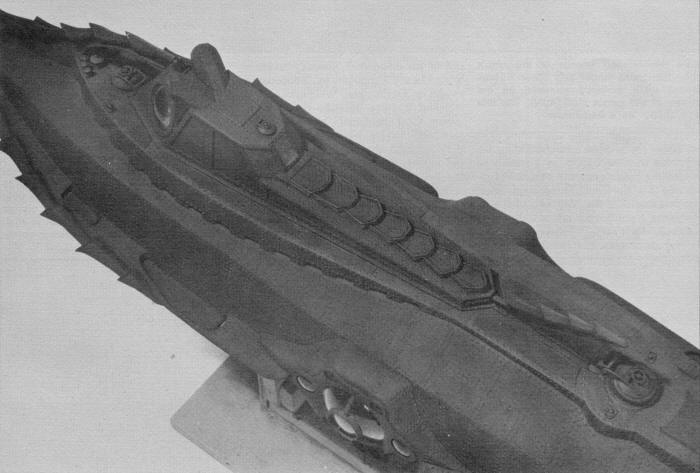 |
|
 |
|
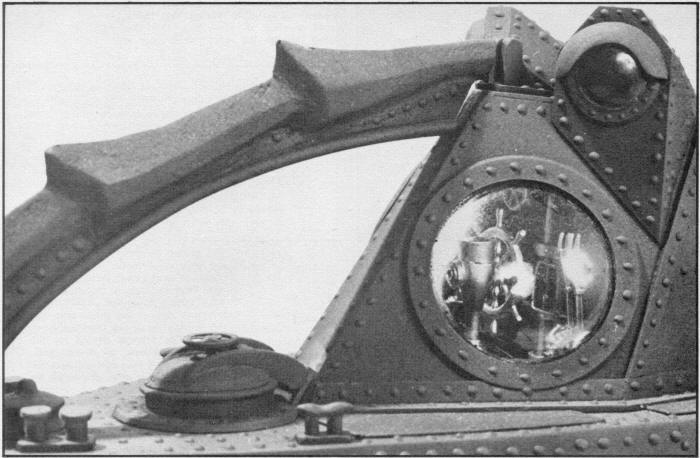 |
||
|
Note the detailed interior of the ship's con. The brass wheel and other various pieces were modeled as seen on the bridge of the movie NAUTILUS. The bits and chalks were handmade. |
out of his office that Tuesday morning, Walt Disney happened by. Spotting the model on Goff's desk, Walt immediately whisked it away into the board room. When Goff returned, he was under- standably beside himself for he could only surmise that someone had stolen the model. Thus it was that he entered the board meeting that afternoon de- jected and empty handed, only to see a smiling Walt Disney eagerly in- specting his new toy. The Nautilus concept was set. Although some changes were made (keeping in mind that the |
original model was very rough), Harper |
|
set about the task of scratchbuilding his Nautilus in model form as a means of presenting more concrete evidence sup- porting his theories. Three days later, the first model of the Nautilus, primarily the same Nautilus we know today, was finished, albeit rather crudely. The story goes that while Goff was |
One of the first questions Tom Scherman is always asked is how he made all of the "teeth" on the NAUTILUS. These units were intended to rip through wooden-hulled ships with a devastating saw-like effect and ran the full length of the hull on four sides. Tom modeled each tooth individually by making a small fe- male mold into which he could pour poly- ester casting resin. The mold, of course, was in the shape of the tooth. Each tooth was then hand fitted into place on the hull. |
|
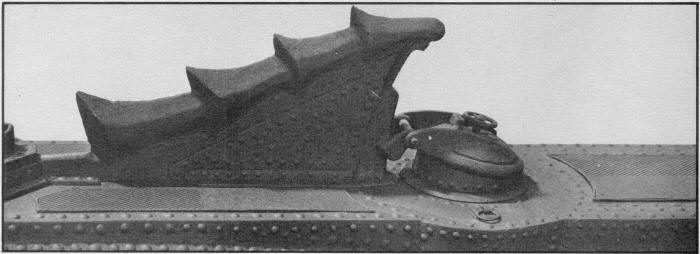 |
||
 |
||
 |
||
|
The tail portion of Tom's NAUTILUS was made from several layers of laminated sheet plexiglass which was sanded to the correct shape. Of particular note on the NAUTILUS was the single five-bladed propeller. At a time (1954) when current submarines utilized two screws, and al- though the book was even specific on the point of using dual props, Harper Goff chose to go with a single screw. It seems strange that this would be the same propeller configuration adopted by the modern nuclear submarines of the 1970s. __________________________________ |
for instance). This unit was 20" long and included all the upper surfaces of the ship. It was used exclusively in the old 20th Century-Fox backlot tank where the surface sequences were shot. Another section of the Nautilus was built and attached to the U.S. Navy submarine Redfish for a few filming sequences which were done off the coast from San Diego. As with most models used in movies, only enough was done concerning mod- els and set design to accomplish the |
purpose of any one particular scene in the movie. Neither Goff nor the Dis- ney technicians ever worked out a full interior for the sub and indeed, this has been a particularly perplexing problem for model devotees. Many other en- gineering questions were simply brushed over in the movie, as well they should have been. Readers will remember that although there were several references as well as a scene in the power room, no details were ever discussed as to the mystical propulsion unit. |
| Goff's
Nautilus idea would soon be- come reality of a sort. Obviously, no full size operating ver- sion of the Nautilus was ever con- structed. For the shots where the entire ship would be viewed from under- water, Disney technicians built an 11- foot model, the same model that was used for many years in the window dis- play of the 20,000 Leagues Under The Sea attraction at Disneyland. An- other partial model was constructed for the shots where the Nautilus would be shown running with decks above the surface (during the ramming sequences, |
 |
|
 |
||
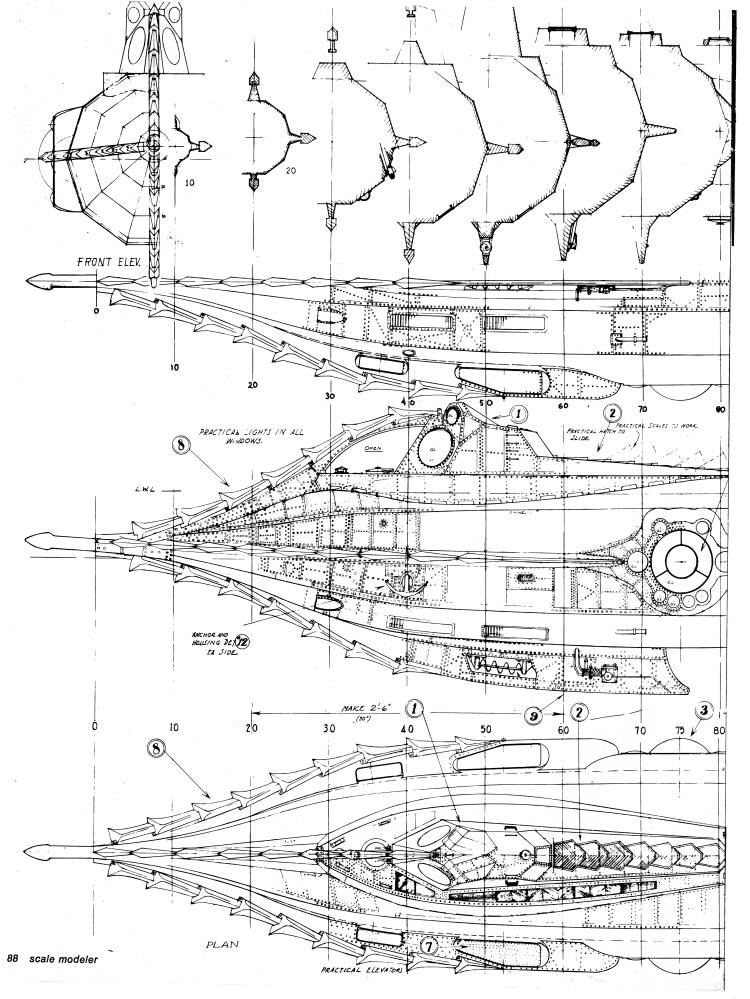 |
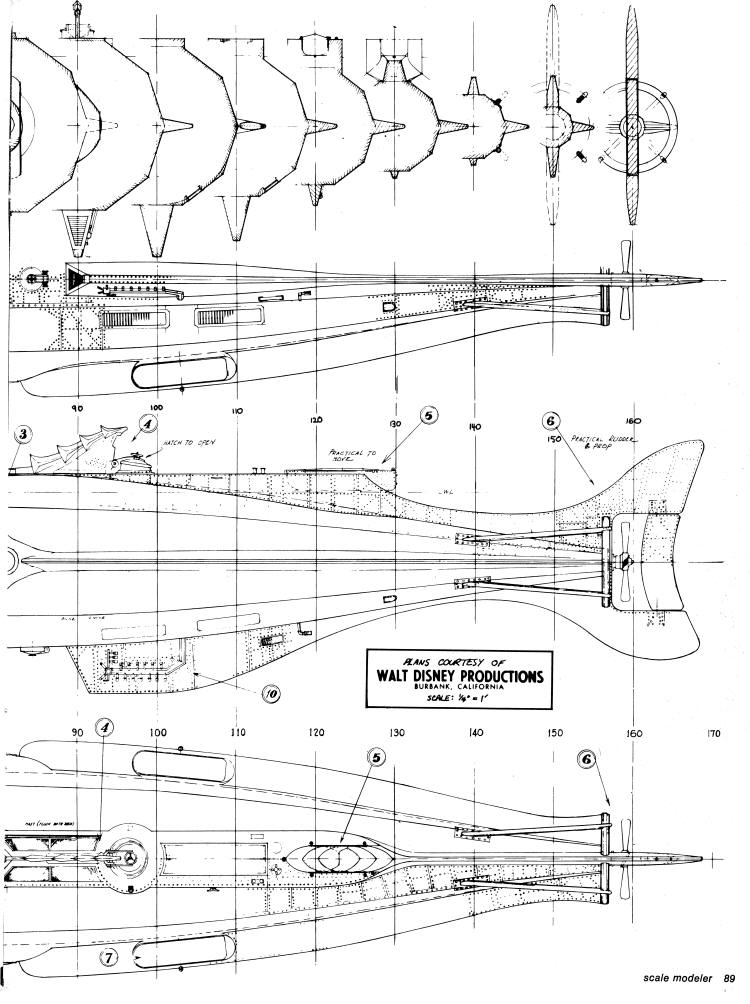 |
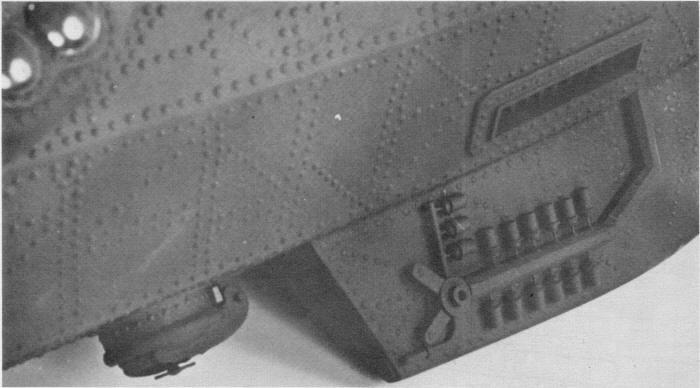 |
||
|
Here is seen one of the many vague en- gineering feats as adopted for use on the NAUTILUS as designed by Disney Studios. Near the keel is this unit known as a "phosphoric atomizer." What it does, no one seems to know. Note also in this shot the bottom hatch through which divers passed in and out of the sub. The |
hatches were turned from pieces of plexiglass while the small hatch wheels are the only cast metal items on the ship. |
Seen in this view are several interesting items. Obviously, one is an anchor. The grate-covered rectangular holes are in- lets for ballast water. The screw device is the speed indicating apparatus and the unit just to the rear of the screws is re- ferred to simply as a "condenser." |
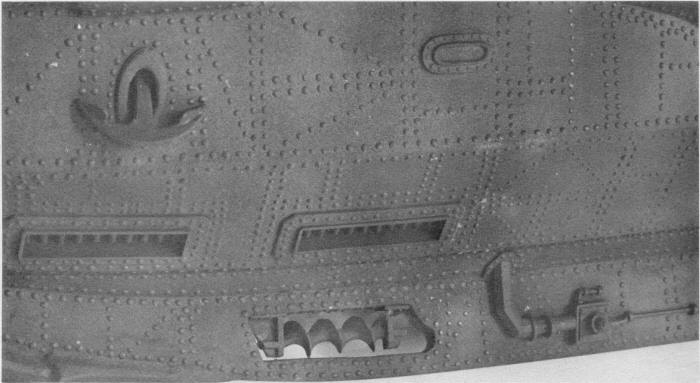 |
||
 |
||
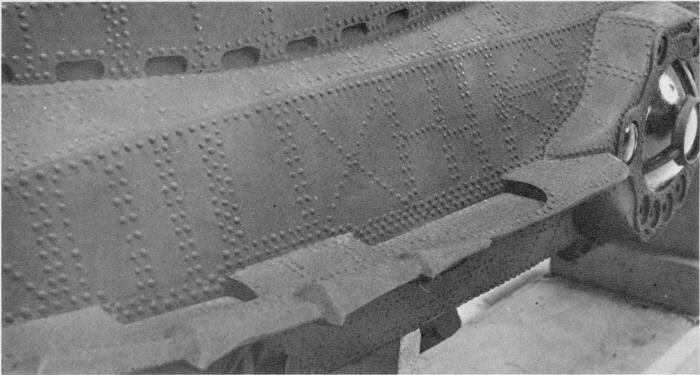 |
||
|
Shown here are two of the ship's diving planes. Many question the practicality of such small units in attempting to sub- merge a ship the size of the NAUTILUS, but it is doubtful whether the issue will ever really be solved. The NAUTILUS did take On water for submerged op- eration, but unlike typical submarine de- sign whereby the water is stored in an outer hull, ballast on the NAUTILUS was held in large diameter steel tubes which ran the length of the ship. Not only did these tubes theoretically hold the ballast water for submerged running, they were also the basic structural framework from which the NAUTILUS was built up, that is to say, had there really been a NAU- TILUS. This was in keeping with the believability theme of the movie for in actual fact, it was widely held during the |
1860s that this tubular method of con- struction was the way of the future. Building a scale model of the Nauti- lus is not an undertaking for the ama- teur. Ever since he first viewed the movie in 1954, professional model mak- er Tom Scherman of Hollywood, Cal- ifornia, has been enchanted with the sleek underwater ship and everything associated with her. In 1971, he began construction of his masterpiece, but not before completing a model of Harper The ship's boat in the movie saw much action in the company of Kirk Douglas. The ship's boat on Tom Scherman's NAUTILUS was carved from plexiglass. |
Goff's prototype. This was a relatively small model and was done by Tom Scherman for Mr. Golf as that first crude model had long since been lost. Tom chose to build his rendition of the Nautilus using plexiglass as the major structural component. Using old sketches and official Disney plans of the outer hull, he constructed a rigid framework of plexiglass bulkheads and formers, and then used 1/32" and 1/64" sheet to skin the model, along with a bit of auto body filler here and there. A special plexiglass cement was used throughout. The only wood on the model is to be found on the deck in the form of grating. Here Tom used scribed decking material available from model shops. The "eyes" of the Nautilus, together with the several windows around the salon area, were made from clear vacu- formed plastic sheet. The finishing touch was the rustic paint job, the unique color being derived from a mix- ture of black and burnt sienna acrylic. Interestingly enough, there seems to be quite a cult developing around the subject of the movie and the submarine itself. Tom Scherman is probably the foremost leading authority in this field and has informed us that he will at- tempt to answer any mail we pass on to him. Readers should address their letters to this magazine, care of the BOATING EDITOR and include a stamped, self-addressed envelope. |
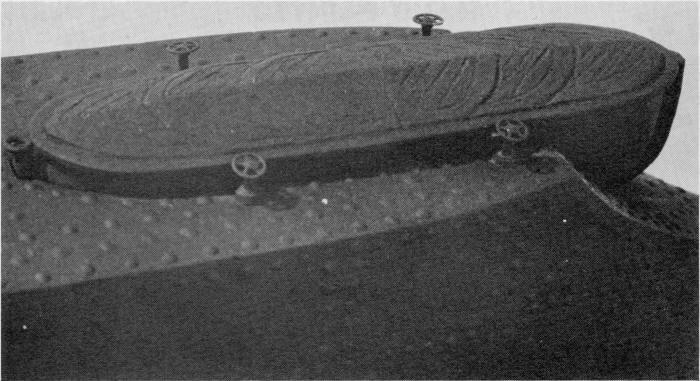 |
||
 |
||